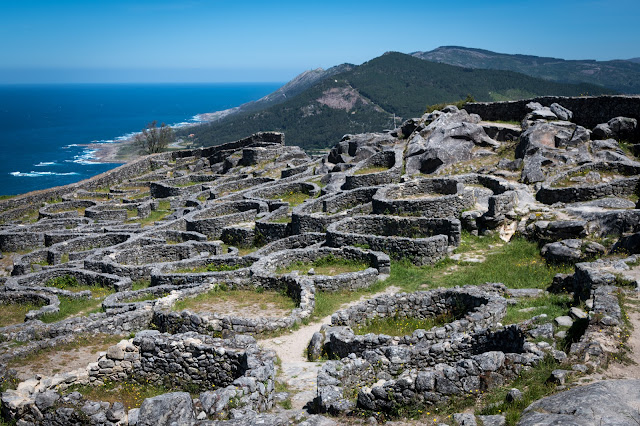We drove from Porto up to the north of Portugal, and crossed the frontier into Spain. There are no formalities between two nations in the EU.
Río Miño, the river between Portugal and Spain. Portugal on the right.
Santa Tegra, a neolithic village.
Xavestre Apartments, our AirBnB in Santiago. The wall on the right is an outer wall of the cathedral from which loud bells rang, and the end of the lane was the site of a loud Heavy Metal band in the Ascensión Festival. Spaniards will use any excuse for a party.
Religious festival Heavy Metal band
Street audience. Stone buildings give great acoustics.
The cathedral of Santiago de Compostela, with some pilgrims arriving. The famous Camino de Santiago ends at that spot.
For those who don't know about it, the pilgrimage is a big deal and attracts hundreds of thousands of people every year; 327,378 in 2018, or an average of nearly 1,000 per day. The story behind it requires the suspension of disbelief for anyone with a skeptical bent.
I'll try to give you a summary. Santiago is derived from the name of Saint Iago or Saint Jacobus.
St James (aka Jacobus) was one of the sons of Zebedee and Salome. St John was his brother. Salome was the Virgin Mary's sister, thus he was Jesus' cousin, and the Virgin Mary was his aunt. He and John were among the first members of the gang called the Apostles.
St. James was ordered to preach Christianity in Hispania after the death of Jesus Christ, sometime around the year 40 AD. The apostle arrived at a southern port on the Iberian peninsula, making use of the busy Roman maritime traffic. He went north through Portugal and arrived at Iria Flavia, where he continued to preach and to move eastwards. Around two years after his arrival, he decided to return to Palestine. When he got back to his homeland, he was denounced by the Jews, and Herod Agrippa ordered him to be beheaded. His disciples brought his body to Spain for burial. One version says that he was brought in a stone boat, with no rudder, navigated by two angels.
Fast forward 800 years to 813 when the relics were 'rediscovered' in Santiago. Remember that the Moors (Muslims) had conquered most of the Iberian peninsula in 711, and the Christians were somewhat disgruntled about that. One, possibly mythical, reason was that the Moors demanded an annual tribute of 100 virgins, fifty noble and fifty lower-class.
The frontier then between Al-Andalus, the Moorish state, and the Christians was the Douro River, so the area north of that was Christian.
Al-Andalus in about 800
The Christians aspired to achieving a 'reconquista' and pushing the Moors back out, back to Africa, a feat which took nearly another 800 years, until 1492, to complete. The discovery of St James' relics had the effect of crystallizing Christian opposition to the Moors. He subsequently became the patron saint of Spain.
Santiago de Compostela was the centre of the effort to 'reconquer' the Iberian peninsula. St James was its symbol. The pilgrimage to Santiago began partly to bring reinforcements to the war against the Moors.
At convenient times St James would come to life and join in battles, such as the Battle of Clavijo in 844, helping the Christians to win. He acquired the title 'St James the Moor-Slayer' (James Matamoros).
St James the “Moor-slayer” statue in Santiago de Compostela cathedral
You know how symbols can have different meanings in different contexts. The Union Jack or the Australian flag can be symbols of national pride and identity in a benign and affirmative way. They can also be a symbol of one side in a conflict, such as the Cronulla riots in 2005, in which conflict broke out between Aussie surfies and Middle-eastern migrants.
Cronulla riots
I find it plausible to view the Camino de Santiago in that context. It started as a part of a long religious war. It served a function for to the Christians which was independent of the truth of the legend. The Camino might be not unreasonably described as the Christian Jihad Walk. A non-partisan spiritual stroll for New Age baby-boomers it ain't, at least in the minds of Muslims.
It currently serves a number of functions for the people who participate, some religious and some not.
Here is an article about it, which generally seems valid to me. We walked a few short lengths of it; mostly along roads with trucks whizzing past nearby. It is not remotely like the Milford Track or the Inca Trail, both of which we have walked.
Leaving that issue aside, Santiago is a beautiful, fun city, with some lovely countryside around it. We drove out to Finisterre.
Finisterre, the 'end of the Earth'.
Finisterre Lighthouse
Waterfall of Ézaro















No comments:
Post a Comment